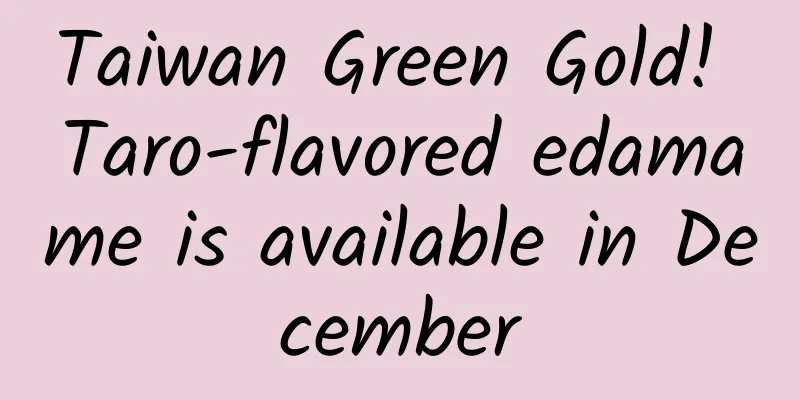Taiwan Green Gold! Taro-flavored edamame is available in December

|
After 10 years of selection and breeding, the Council of Agriculture's Kaohsiung Agricultural Improvement Station launched a new high-yield and high-quality taro-flavored edamame variety "Kaohsiung No. 11 - Fragrant Honey" this year. It is Taiwan's first independently hybridized taro-flavored tea bean variety. The bean kernels not only have a strong taro flavor, but also have the characteristics of large pods and high yields. It has increased production by more than 25% compared to the Japanese Xiangji tea bean variety. It is ready to be authorized for use in the industry to continue to expand the export territory of "Taiwan Green Gold". The annual export value of Taiwan's edamame products reaches more than 60 million US dollars, and its market share in Japan is 41.8%, ahead of competitors such as China and Thailand. (Photo courtesy of the Council of Agriculture) Zhou Guolong, an associate researcher at the Agricultural Research Laboratory, said that Taiwan's agriculture is amazing. Rice can have a taro flavor, and edamame can also have a taro flavor. In addition to emitting fragrance, taro-flavored edamame can also be smelled and tasted. Put it in your mouth and chew it carefully, the rich taro flavor will make you praise it endlessly. For a long time, most of the taro-flavored edamame grown in Taiwan has been the Japanese tea bean variety, but the pods of the "tea bean" are relatively small and the yield is lower. The Kaohsiung Farm started a breeding program for local taro-flavored edamame in 2001. After 10 years of selection and cultivation, this year it launched a new variety of tea beans with a strong taro flavor, "Kaohsiung No. 11 - Fragrant Honey." This variety is better than its parent, not only retaining the taro fragrance of its mother plant, "Xiangji Tea Bean", but also has the characteristics of large pods and high yield, increasing its yield by more than 25% compared to the "Xiangji Tea Bean" variety. Zhou Guolong pointed out that the annual export value of Taiwan's edamame products reaches more than 60 million US dollars, and its market share in Japan is 41.8%, ahead of competitors such as China and Thailand. Among them, "Kaohsiung No. 9" accounts for about 80% and taro-flavored edamame accounts for about 20%. In Japanese supermarkets, a 400-gram bag of frozen edamame with taro flavor costs 100 yen more than the regular edamame flavor. The "Kaohsiung No. 11-Xiangmi" variety is the result of Taiwan's independent hybrid breeding. It is a genuine MIT and is expected to enhance the competitiveness of Taiwan's edamame products in the international market after promotion. The Council of Agriculture's Kaohsiung Agricultural Improvement Station launched a new high-yield, high-quality taro-flavored edamame variety this year, "Kaohsiung No. 11 - Fragrant Honey." It is Taiwan's first independently hybridized taro-flavored tea bean variety. (Photo courtesy of the Council of Agriculture) Zhou Guolong emphasized that in the past, Taiwan's export companies looked for farmers to contract to grow Japanese Koji tea beans. In order to avoid seed mixing and mutation, they had to purchase seeds from Japan every 3 to 5 years, at a cost of around NT$1,000 per kilogram. Today, Taiwan has its own taro-flavored tea bean variety, "Kaohsiung No. 11 - Fragrant Honey," which not only helps Taiwan break away from its reliance on Japan, but also gives Taiwanese consumers who like to eat edamame a chance to feast on their delicious taste buds. The variety has applied for plant variety rights in the country and is currently under public review. It is expected that professional soybean farmers will start trial planting this fall, and will cooperate with processing industries to develop taro-flavored tea bean products. Therefore, consumers will be able to eat authentic Taiwanese taro-flavored edamame in December. |
<<: Creative Champion Whole Grain Bread Fruit Filling Makes It More Delicious
>>: South Korean oysters found to contain toxic bacteria, health agency to destroy all
Recommend
3 milk weight loss recipes! Lose weight easily without going hungry
For friends who want to lose weight, milk is a go...
How to treat uterine fibroids? What are the treatment principles for uterine fibroids?
There are certain principles for the treatment of...
What causes uterine fibroids and how to treat them
Uterine fibroids are a common gynecological disea...
Does a thin endometrium of 2mm mean menopause?
Does endometrium thinning to 2mm mean menopause? ...
Knowing the cause of adnexitis can effectively prevent this disease
In recent years, due to the continuous progress a...
What to eat during confinement? Daily calories 2100 kcal
"One person eats and two people benefit"...
What behaviors can easily cause menstrual irregularities?
Irregular menstruation is a common symptom for ma...
What’s the problem if there is excessive vaginal discharge and no menstruation?
What’s the problem if there is excessive vaginal ...
Care plan for threatened miscarriage
Threatened abortion is the most worrying problem ...
What are the most effective treatments for acute pelvic inflammatory disease?
Pelvic inflammatory disease is a gynecological di...
I haven't had my period yet after taking progesterone
I haven't had my period yet after taking prog...
Sitting for a long time and not moving enough will make you gain 3 pounds. Here are 4 magic tricks to fight obesity! Weight loss doctor: Accurate weight loss to prevent weight regain, are you following along?
Many people stayed at home during the epidemic pr...
Can I get pregnant if I have ovarian cysts? What are the medical treatments?
Can I get pregnant with ovarian cysts? What are t...
[Video version] Dementia, aging...the brain is playing tricks! 6 essential nutrients for brain protection
The silver hair wave is unstoppable! The elderly ...
Lose weight without starch? Low-carb weight loss, cauliflower rice recommended
Many people who are fighting against fat on their...









